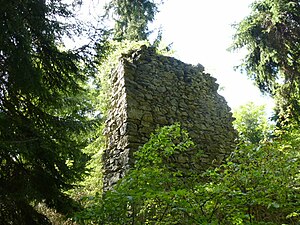Luegg Castle (Semriach)
| Luegg Castle | ||
|---|---|---|
|
The remains of the keep of the Luegg castle ruins near Semriach |
||
| Alternative name (s): | Luginsland, Lueg into the country | |
| Creation time : | around 1300 | |
| Castle type : | Hilltop castle | |
| Conservation status: | ruin | |
| Standing position : | Service men | |
| Construction: | irregular quarry stone masonry | |
| Place: | Semriach | |
| Geographical location | 47 ° 12 '3 " N , 15 ° 23' 26" E | |
|
|
||
The Luegg castle ruins are located in the market town of Semriach in Styria . Its history goes back to around 1300.
Geographical location
The ruin of the Höhenburg is in the cadastral community of Windhof . It stands there on the highest point of the Semriach local mountain , which lies on the southeastern edge of the high settlement area Tanneben and drops steeply to the north, east and south. On the western side, the mountain falls less steeply and is connected to the plateau. About 300 meters northeast of the Luegg ruins are the remains of Forchtenberg Castle . Both were in front of Burg Peggau and Burg Alt-Pfannberg .
history
The castle was probably built around 1300 on behalf of the Counts of Pfannberg . In 1321 it was mentioned in a document as "castrum Luginslant" (' Lug ins Land '). At the time, sat porter sex of Mordax at the castle. It was also mentioned in 1373 as "veste Lueginsland". In 1621 only the old castle is mentioned. It is not known exactly when it was left.
description
The existing structure is so small that the layout and shape of the castle can only be assumed for the most part. The facility was surrounded by a rectangular, around 1.4 meter thick circular wall, which was built in the eastern part directly on the steep slope. A four-meter-high section of the wall in the southeastern part of the complex and some remains of the foundation are still preserved from this wall. On the less steep slopes in the north, south and west, an additional wall and ditch system was built. There was probably a palisade on the shoulder of the wall . The castle was probably accessed from the west. In the southern part of the castle, a five meter high and about one meter thick piece of the northern wall still indicates an almost square keep . This originally had a side length of about eight meters. Both the keep and the curtain wall consist of irregular quarry stone masonry , which indicates a time of origin at the transition from the 13th to the 14th century. The keep has horizontal alignments with a layer height of 40 to 50 centimeters. In the northwest you can find the remains of a rectangular building that was probably built directly onto the curtain wall. In the northeast there is a depression that could indicate a former cistern .
literature
- Werner Murgg: Castle ruins in Styria . Ed .: Federal Monuments Office (= B . Band 2 ). Ferdinand Berger & Sons Ges.mbH, 2009, ISSN 1993-1263 , p. 62-63 .
- Luegg - Luginsland. www.burgseite.com, accessed on March 10, 2012 .
Individual evidence
- ↑ a b c d Werner Murgg: Castle ruins of Styria . Ed .: Federal Monuments Office (= B . Band 2 ). Ferdinand Berger & Sons Ges.mbH, 2009, ISSN 1993-1263 , p. 62-63 .
- ↑ a b c Luegg - Luginsland. www.burgseite.com, accessed on March 10, 2012 .


